Update 06.05.2018 -- Run 9 embedding: new matching algorithm
We recently discovered that I wasn't handling the detector-to-particle matching in the best manner. What tipped us off was the (very small) population of jets at large 'pTdetector' but small 'pTparticle' in the response matrix:

This was a consequence of how I was handling the selection of the "best" match candidate. The matching algorithm I was using went like so:
- Select a particle-level jet.
- For each detector-level jet compute the separation 'dR = sqrt((phiPar - phiDet)^2 + (etaPar - etaDet)^2)' between the particle- and detector-level axes, and the momentum fraction 'qT = pTdet / pTpar'
- If a detector-level jet satisfies 'dR < 0.3' (where 0.3 is the jet resolution parameter) and 'qT > 0.15', then consider it a match candidate.
- From the set of match candidates, the detector-level jet which has the smallest 'dR' and largest 'qT' is defined to be the best match candidate.
- Remove the particle-level jet and its best match from their respective lists, and iterate until there are no more particle-level jets.
This also explains why my jet reconstruction efficiency was a little lower than anticipated (~80%). So we modified the algorithm to go like so:
- Select a particle-level jet.
- For each detector-level jet compute the separation 'dR = sqrt((phiPar - phiDet)^2 + (etaPar - etaDet)^2)' between the particle- and detector-level axes, and the momentum fraction 'qT = pTdet / pTpar'
- If a detector-level jet satisfies 'dR < 0.3' (where 0.3 is the jet resolution parameter) and 'qT > 0.15', then consider it a match candidate.
- From the set of match candidates, the detector-level jet which has the 'qT' closest to one is defined to be the best match candidate.
- Remove the particle-level jet and its best match from their respective lists, and iterate until there are no more particle-level jets.
Step 4 is implemented by requiring that the best match has the smallest 'abs(qT - 1)'. This had a substantial impact on our reconstruction efficiency and response matrix:


The above response matrix (and efficiency) is the combined RFF and FF response matrices (and efficiencies). Here's how the RFF and FF responses compare to each other:


And here's the new efficiency and response matrix with variable binning:


- dmawxc's blog
- Login or register to post comments
